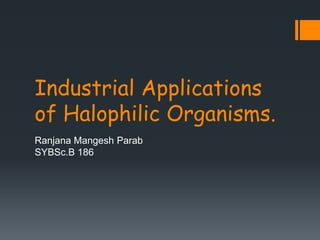
Applications of halophilic organisms .pptx
- 1. Industrial Applications of Halophilic Organisms. Ranjana Mangesh Parab SYBSc.B 186
- 2. Introduction Halophiles are organisms represented by archaea, bacteria, and eukarya for which the main characteristic is their salinity requirement, halophilic “salt-loving”. Halophilic microorganisms constitute the natural microbial communities of hypersaline ecosystems, which are widely distributed around the world. They are found in Hypersalione ecosystems such as: salt marshes, subterranean salt deposits, dry soils, salted meats, hypersaline seas, and salt evaporation pools.
- 3. Examples of Hypersaline Ecosystems: Solar salterns Owens Lake Dead Sea
- 4. Classification of Halophilic Organisms based on salt Concentration Halophiles Slight Halophiles Moderate Halophiles Extreme Halophiles
- 5. Industrial Applications of Halophilic Organisms Used in Fermented foods Used in Production of Enzymes Used in Production of beta-carotene by Dunaliella Used in Production of Ectoine Used in Production of Exopolysaccharides Used for Bioplastic Production Used for Bioremediation in Agriculture Used for Production of Bioactive compounds Used for Biodegradation Process
- 6. Used in Fermented foods • Fermentation is one of the oldest method used for preservation of food. • For the purpose of preservation high amount of natural preservative such as Sugar or Salt are used. • Halophilic organisms that are salt- loving are also used in production of these fermented products on a commercial basis. • Eg: Tetragenococcus strains are used for the manufacturing process of Soya sauce. • A new isolate of Halakalicoccus jeotgali was found in the shrimp jeotgal which is a popular Korean Fermented fish dish made of whole fish or shellfish,
- 7. Production of Enzymes Hydrolytic enzymes produced by Halophiles are highly regarded for their use as Biocatalysts. Lipolytic Enzyme produced by Marinobacter lipolyticus are used in manufacture of Fish and Olive oil. Proteolytic enzyme by Halobacillus karajenesis has been extensively employed in baking, brewing and dairy sectors. Bacterial Amylases produced by Thalassobacillus is used in starch stratification in textile,food, brewing and distilling industires.
- 8. Production of B-Carotene by Dunaliella The Beta-Carotene extracted from Dunaliella salina is used as a colorant, an immunostimulator, and as an antioxidant by the cosmetic, pharmaceutical and nuitrtition industries respectively. The extraction of the beta-carotene can be done by various methods: 1} Combination of Polar-Non-polar Solvents 2} Flocculation 3} Surface Adsorption 4} Centrifugation Beta-carotene
- 9. Ectoine Production Ectoine serves to stabilize the physiological properties of the cells and protect them from external osmotic stress, caused by high salinity, heat, loss of water and UV irradiation. Ectoin is a synthetic or naturally- derived ingredient that acts as an emollient on skin and can also have a buffering and anti-pollution effect in cosmetic formulas. Industrially, ectoine is produced by Halomonas elongata through a “bacterial milking” process.
- 10. Production Of Exopolysaccharides Exopolysaccharides acts as an environmental stress protecting agent, helps in adhesion to surfaces, plays a role in pathogenesis, etc. The exopolysaccharide produced by Halomonas spp can synthesize polymers with a variety of physico-chemical properties. Exopolysaccharide produced by Halomonas maura is used as viscofier and as a gelling agent in food industry. Halophilic exopolysaccharide also has the ability to remove dangerous heavy metals and dyes.
- 11. Bioplastic production The Polyhydroalkonates (PHA) are a natural linear polyster that are produced by microbial fermentation which are used for the manufacture of Biodegradable Plastic. Amongst the various classes of PHA, PHBs are the only one that are completely biodegradable, making them an ideal option of protecting the environment from the plastic pollution. PHA producing Halophilic organisms: Haloferax mediterranei, Halomonas elongate, etc.
- 12. Bioremediation in Agriculture Plant Growth Promoting Bacteria, the halophiles are now being employed as an inoculant in the production of Biostimulants, Biofertilizer for plant pathogen biocontrol. Halomonas are frequently employed halophiles that reduce salt stress and promote plant growth. Along with Halomonas, reported Plant Growth Promoting Bacteria are Ochrobactrum, Acinetobacterium, Oceanobacillus and others
- 13. Production of Bioactive Compounds For finding new sources of antimicrobial chemicals to develop effective medications against pathogenic bacteria, that have become resistant to the former, Halophiles have been employed widely. Halocins, a proteinaceous antitumor and antimicrobial agent has been discovered from mild and severly halophilic prokaryotes. Other class of Halobacteria that have shown to produce antimicrobial activity include: Natrinema, Natrialba, Haloarcula, Halopiger, etc.
- 14. Biodegradation Process Halophiles have been used for the process of Biodegradation of sewage sludge. Halophiles for example, Sporohalobacter marismortui and Haloanaerobium praevalens are obligatory anaerobic eubacteria that has the potential of quickly reducing aromatic nitrogenous compounds found in abundance in the sewage sludge.